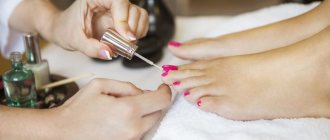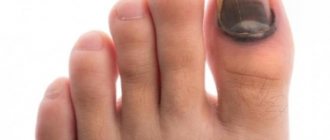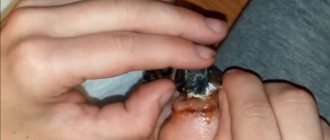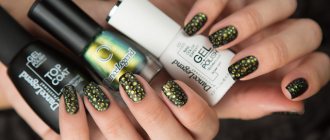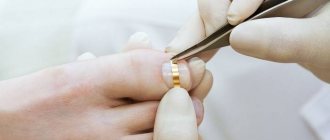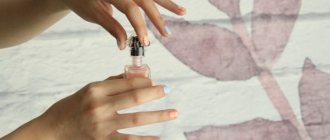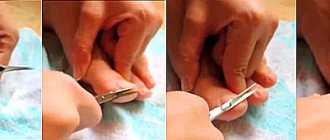Hands are a calling card for any girl.
An ideal manicure will speak of its owner as a neat and well-groomed person. Many girls are concerned about the slow growth of nails , which makes it impossible to get a beautiful manicure.
However, in this case, nail care products at home , which significantly accelerate their growth.
Aesthetic beauty of long nails
Neat long nails are, first of all, aesthetically beautiful. Short nails are more relevant for the stronger half of humanity, while girls should stand out with long nails.
Beautiful long nails are relevant and necessary for girls in such professions, for example, as a consultant in a jewelry salon, models and fashion models, and beauty salon technicians.
When working in such areas, beautiful long nails with a perfect manicure are essential.
Nail growth rate
| On average, the rate of nail growth for all people is approximately the same. On average, nails lengthen by 3 millimeters . It takes 3 to 6 months fingernail to be completely renewed . A person's toenails renew in 12-18 months , which is three times slower than the growth of fingernails. |
There are studies that show that nails grow faster on the working hand.
The speed of nail growth is also affected by the time of year - it has been found that nails grow a little faster in summer than in winter. There is still no clear answer to what this is connected with. It is believed that in summer the hands are more mobile, which indirectly affects the growth of nails - according to the site.
The longest nail was recorded in a woman and was 601 mm.
But due to individual characteristics, metabolic disorders and various diseases, nails become brittle and fragile. This is the main reason for the problem of short nails.
As you age, nails begin to grow more slowly. This is due to the fact that the older a person is, the less actively all his structures work, including the production of keratin, the base of nails.
In children, the rate of nail growth is approximately one and a half times greater than in adults. This growth of nails continues until puberty - source
Also, nail growth slows down when there is a lack of sufficient amounts of protein, vitamins and microelements in the body.
In a young and completely healthy body, the following factors can cause a change in the rate of growth of the nail plate:
- pregnancy (nails may grow faster or slower than usual);
- period of lactation and breastfeeding;
- regularly washing dishes with detergents without using protective gloves (slows down nail growth);
- active adherence to any diet;
Also, regular use of shellac and nail extensions significantly slow down the growth of nails, due to insufficient oxygen supply to the nail plate.
Unlike the popular belief that nails grow after a person’s death, this is not true. Drying of the skin on the fingers creates the appearance of nail growth.
How does the nail growth process occur?
Nails are keratinized tissues formed in the form of a plate. Located on the back of the ends of the fingers both the upper and lower extremities, most primates have them.
The function performed by the nail plate is to protect the ends of the phalanges of the fingers. This arrangement is caused by the need to protect soft tissues and nerve endings located among them from damage. These protection products are made of a protein called keratin. Such explanations are given by encyclopedias.
Keratin is the main building element not only of the nail plate, but also of hair.
If you believe Darwin's theory, then our ancestors are monkeys. In these primates, protective plates at the ends of the fingers can serve for defense and climbing trees. They're almost like claws.
The nail plate does not have blood vessels or nerve endings, therefore, this tissue is non-living. But at the same time it can grow. The plate is made from more than a hundred keratinized plates by layering one on top of the other.
The semicircle at the base of the nail is called a lunula. It is here that the cells that produce carotene are located, that is, they form new fragments of the plate. The location of the lunula is clearly visible in the photo:
In a lunula, new produced tissue is added to an existing part. At the same time, the nail is pushed forward - it grows. There is a narrow area of skin above the lunula. It is called the cuticle. This protects the lunula and the base of the plate from bacteria entering them, as well as from mechanical impact.
With age, the growth process of the plate slows down. Often during this period, all sorts of patterns, dots, lines or dents begin to appear on or under the nail. The reasons for this manifestation lie in the body, which thereby signals internal problems. It is the plate that first begins to show its owner that he has some kind of disease.
Biologically, the growth process of fingernails and toenails is no different. There is a difference in the speed of their regrowth.
A very interesting illustration, in it the growth zone is called not a lucula, but a hole, which is also acceptable:
This is how nails grow. Click on the picture to enlarge!
This video will help you figure out the issue; it also gives recommendations for accelerating growth:
Growing marigolds at home
Every girl has her own preferences for the shape of her nails, some like round ones, some prefer square ones, and others even like oval ones. Whatever shape you choose, remember that it is best to file your nails with a special nail file rather than cut them. If you follow this rule, you will soon notice that their growth rate will increase, and they will look much more beautiful and well-groomed.
If you are used to removing cuticles during a manicure, then do it correctly - do not forget to soften it properly. It’s quite easy to do this at home – just hold your hands in a warm bath. So, how to make your nails strong:
- In fact, nails are given to a person not only for beauty - they perform a very important function, which is to protect the fingertips, which is why they have to endure heavy loads every day. Almost all manufacturers of household chemicals claim that their products are so safe that they do not have a negative effect and even take care of your hands. In fact, this is not the case, so you should only wash dishes with gloves.
- Each nail, just like our hands, needs proper hydration, especially in winter, so do not forget to constantly rub oil and special creams into them.
- File your nails regularly and try to give them the same shape, this way you can avoid getting caught and therefore breaking them.
- The growth rate of marigolds is also affected by varnish, which can be purchased at almost any pharmacy chain. You can use both transparent and colored varnishes; this coating not only protects the nail plate from damage, but also gives them an attractive and well-groomed appearance.
- After using nail polish remover, wash your hands, as it dries out the nail plate very much, so they will not become healthier from such exposure.
- Nail massage using various medicinal oils and manicure certainly have only a positive effect. These procedures can be easily performed at home; you do not have to constantly visit a beauty salon.
- Do not bite your nails under any circumstances. If you have a habit that adversely affects the condition of the nail plate, try to get rid of it as quickly as possible.
Since the growth of the nail plate is predetermined at the genetic level, of course, it will not be possible to significantly speed up the process, but if you follow all the above rules, you can achieve good and impressive results, even at home.
How to make your nails strong using vitamins: firstly, if you do not eat meat, then you should focus on taking various calcium supplements, and secondly, do not forget to maintain water balance in your body - drink as much water as prescribed daily norm, thirdly, buy yourself B vitamins, since they are the ones that can prevent brittle nails.
And remember, success depends entirely on your actions, the more you pay attention to detail, the more noticeable the result will be.
How to grow a nail back after removal
In advanced stages of onychomycosis, doctors prescribe removal of the nail. There are several ways to do this:
After removal, a new nail will grow after a certain time - this will take 3-6 months. The speed at which a new nail will grow depends on various factors.
Firstly, this is influenced by the patient's age and gender. Nails grow faster in young people under 20 years of age, as well as in pregnant women. Secondly, nail growth depends on the time of year. The nail plate grows well in warm climates.
If you want to recover faster from an illness, you can go to a resort or wear warm gloves when going outside in the fall and winter. The third factor influencing the speed of nail recovery is hormonal levels and general health.
Weakened people with reduced immunity take longer to recover. You need to avoid colds and take vitamins. An interesting fact is that nails on the “working” hand grow faster.
The fungus must be treated comprehensively until complete recovery. Only in this case can you count on victory over the fungal infection, rapid restoration of the nail plate and protection from relapses.
It is not always necessary to use expensive drugs in treatment. At the initial stage, you can use traditional medicine recipes if the attending physician does not mind.
Onychomycosis is a disease that affects the nail plate on the hands or feet.
The disease is caused by a fungus that can be picked up in public places (saunas, swimming pools) or by trying on someone else's shoes and clothes. The fungal pathogen spoils the structure and appearance of the nail plate - it becomes loose, dull and brittle.
If onychomycosis is not treated in time, the fungus spreads to the area under the root of the nail, where cells of the new plate are formed. It is this part of the epithelium that is responsible for whether the nail grows back beautifully after fungus or becomes deformed.
Those who neglect to see a doctor should take the problem seriously, otherwise the course of the disease will become chronic, and dystrophic onychomycosis will negate the hope of restoring the nail after fungus.
The process is irreversible and cannot be cured. The matrix epithelium becomes scarred and the nail no longer grows. Therefore, it is important to quickly contact a dermatologist or infectious disease specialist when the first symptoms of a fungus are detected.
How fast do nails grow?
If you look at the speed at which fingernails grow, it turns out that the average length to which they can grow daily is a maximum of 0.15 mm. Therefore, in a month this process is approximately 4 mm. For a year, after multiplying, we get the following answer - up to 5 cm.
The regrowth time may vary depending on age, general health and chronic diseases present in the body.
The only answer to the question of how long nails grow is: while a person is alive! However, saying so is a mistake.
If you refuse to cut your hair, the growth will not continue for very long. Nails grow until they reach a certain length, and then they stop growing. This was confirmed by record holders from the book of records. It is difficult to say how long they grow over time, it all depends on the state of the individual’s body, but decades – that’s for sure.
At what speed and how long do nail plates grow, an additional question plays an important role: on which finger? There is one direct relationship. The longer the finger, the faster the nail grows on it.
How do they grow?
Nails grow throughout a person's life. Constant renewal promotes complete recovery if there is no matrix damage. The average growth rate varies between 0.7 and 1 mm per week. The nail plate is completely renewed after six months. On the legs, growth is slowed by 10–15%. This is due to the fact that the hands, with frequent contact with water, are saturated with moisture and oxygen, and the legs are closed during the day. Nails grow faster:
- In summer than in winter. This is affected by light levels and temperature.
- With increased estrogen levels, pregnancy or taking hormonal contraception. Menopause slows growth.
- At a young age, which gradually slows down by age 25.
- When actively working with the keyboard, your nails receive a kind of massage, speeding up metabolic processes.
- With a balanced diet. Strict diets, as well as a monotonous and meager diet lead to slower growth.
